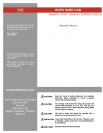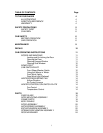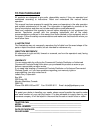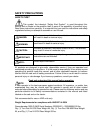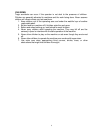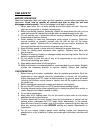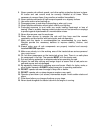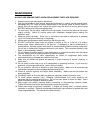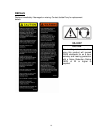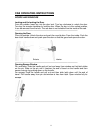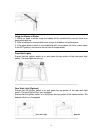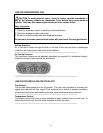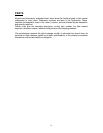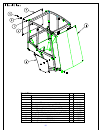
MAINTENANCE
ALWAYS USE GENUINE PARTS WHEN REPLACEMENT PARTS ARE REQUIRED.
1. Keep the tractor and cab properly maintained.
2. Park the tractor/cab on level ground, place the transmission in neutral, set the parking brake,
disengage the PTO, lower all tractor attachments to the ground, place all control levers in
neutral, shut off the engine and remove the ignition key and allow all moving parts to stop
BEFORE making any tractor/cab adjustments.
3. To avoid injury, do not adjust, unblock the driving system, or service the cab with the tractor
engine running. Make all moving parts have completely stopped before leaving the
operator’s seat.
4. Keep the tractor/cab clean. Snow, dirt, or ice build-up can lead to malfunction or personal
injury from thawing and refreezing in the garage.
5. Always were eye protection when cleaning or servicing the cab.
6. DO NOT service the tractor while the engine is running or hot, or if the unit is in motion.
Always lower tractor attachments to the ground. If necessary to service attachments in
raised position, securely support with stands or suitable blocking before working underneath.
Do not rely on hydraulically supported devices for your safety. They can settle suddenly, leak
down, or be accidentally lowered.
7. Do not attempt to service machine, clear obstructions, or unclog drive system with the engine
running. Always shut off engine and allow all motion to cease.
8. The manufacturer will not claim responsibility for fitment of unapproved parts and/or
accessories and any damages as a result of their use.
9. Make sure all shields and guards are securely in place following all service, cleaning, or
repair work.
10. Do not modify or alter cab or any of its components or operating functions. If you have any
questions concerning modifications, consult with your dealer.
11. Do not operate a cab that is defective or has missing parts. Make sure all recommended
maintenance procedures are completed before operating cab.
12. Check all controls regularly and adjust where necessary. Make sure that the brakes are
evenly adjusted.
13. Periodically check all nuts and bolts for tightness, especially wheel hub and rim nuts.
14. To avoid serious personal injury: Escaping hydraulic/diesel fluid under pressure can
penetrate the skin causing serious injury. Do not use your hands to check for leaks. Use a
piece of cardboard or paper to search for leaks.
15. Stop engine and relieve pressure before connecting or disconnecting hydraulic hoses.
Tighten all connections before starting engine or pressurizing hoses.
16. Ensure cab hinges are properly lubricated. If hinges are closing hard, or partially seized,
lubrication is required. Remove door/escape window/side vent windows to grease each part
of the hinge separetely. This should occur semi-annually.



